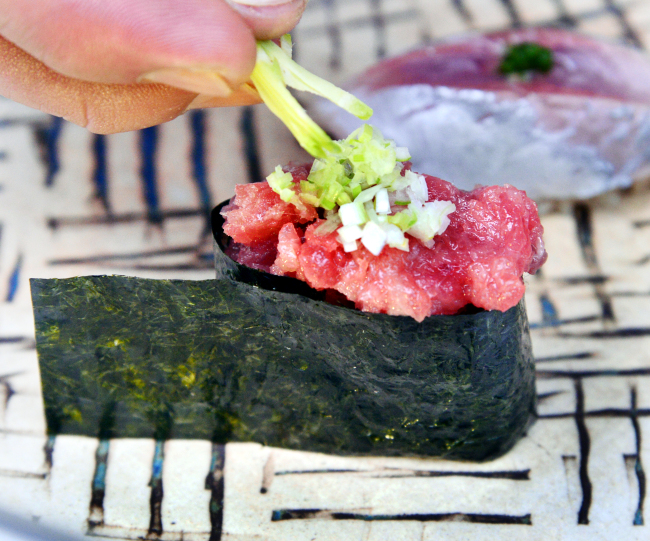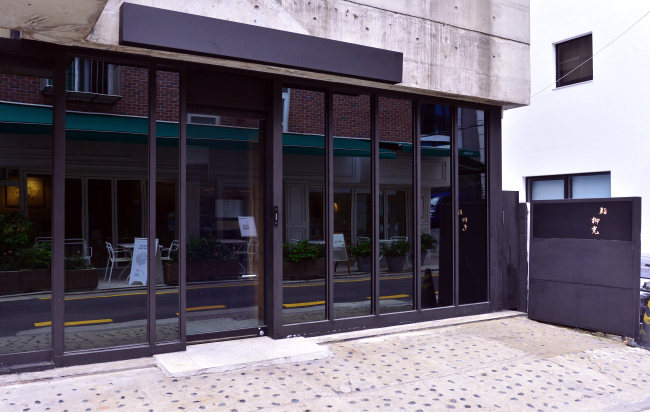In a city with plenty of sushi options, it can be a challenge for a new sushiya to stand out from the crowd.
Sushi Ryukou took that risk, opening in Sinsa-dong this August.
“I wanted to show my own personal approach to sushi,” co-owner and chef Kim Kwang-min, 33, said.
Kim honed his skills while studying and living in Japan for six years and racked up more experience at a Seoul hotel.
 |
Sushi Ryukou‘s negi toro maki (front) is beautifully layered with sushi rice, nori, tuna, the white part of the onion and that final touch -- slivers of fresh wasabi -- while the equally toothsome aji, or Japanese horse mackerel, keeps it simpler, with a fragrant topping of grated ginger and green onion. (Park Hyun-koo/The Korea Herald) |
When the opportunity arose, Kim teamed up with co-owner and head chef Ryu Myeong-yeol to helm Ryukou, a small space specializing in Edo-style sushi with eight counter seats and a five-seat room.
The moment the first dish, an egg custard called “chawanmushi,”is served, one can immediately sense the team behind this new sushiya is not afraid of bold flavors or textures.
An ice cold sherbet of crab entrails adds an umami salinity to the mild custard, while tiny fried crabs add a memorable crunch.
The contrast of temperatures from ice cold to warm, the contrast of flavors from punchy to very mild and the contrast of creamy and crunchy textures make for an appropriate introduction to Ryukou.
 |
Sushi Ryukou, which specializes in Edo-style sushi, opened in Seoul’s Sinsa-dong in August. (Park Hyun-koo/The Korea Herald) |
By the time the last bit of custard has been scooped up, it is as if the palate has been activated and prepped for what is to come -- a parade of multifaceted, flavorful sushi.
The sushi at Ryukou derives part of its attitude from its “shari,” sushi rice.
Ryukou’s shari is almost beige in color from the amount of “akazu,” red vinegar made with sake lees, used to season the rice.
“I like the smell of the sake lees,” Kim explained, elaborating that their sushi rice is seasoned with the vinegar and salt and nothing more.
“We want the rice to possess a certain elasticity and to also be soft,” he added, explaining that Ryukou sources Koshihikari rice from Gyeonggi Province.
The slightly tangy canvas of the shari is quite delicious, with the vinegar seeming to coax out the sweet flavors of the rice itself.
Then there is the warmth of the shari.
The shari is consistently warm. In fact, one can watch Kim constantly shuttling back and forth to refill his bucket with those warm, soul-satisfying grains of rice.
Kim explained how he replenishes his supply of sushi rice depending on the “neta,” sushi topping, explaining how he prefers slightly less warm rice for white-fleshed fish and wants the rice to be warm when paired with oily fish so it meshes well with the oil from the fish.
With that shari, Kim, for instance, may take a delicate slice of “shima aji,” striped jack, before squeezing fragrant “sudachi,” a green citrus, over it.
The acidity of the citrus, the tang of the vinegar from the rice and the sweet, cool meatiness of the fish melt into one another.
Later on, he may take thin, flat threads of cuttlefish, top them with threads of shiso leaf and sprinkle sesame seeds over everything before mixing it all together and molding it delicately over the rice.
A squeeze of sudachi over the sushi amps up the already fragrant morsel for an aromatic interplay of citrus and shiso, the nutty crunch of sesame and the very cold, gelatinous chew of cuttlefish.
Kim clearly understands the art of layering.
 |
Sushi Ryukou co-owner and chef Kim Kwang-min and co-owner and head chef Ryu Myeong-yeol helm this new sushiya. (Park Hyun-koo/The Korea Herald) |
When serving “amaebi,” sweet shrimp, Kim dabs a blend of shrimp and egg rendered into fine crumbs on the shari before topping it with amaebi.
“I wanted it to be sweeter,” he explained.
Slivers of fresh wasabi are layered over the white part of the onion and minced tuna for Ryukou’s “negi toro maki.”
Layering, however, is not Ryukou’s sole philosophy.
There is bare simplicity as well.
On a day when the “saba,” mackerel, is particularly to Kim’s liking, he will simply coat it with a brushstroke of “nikiri,” a sauce usually comprised of soy sauce, mirin and sake, and serve it.
If there was a unifying philosophy to the sushi at Ryukou, it would probably be seasonality.
Kim revealed that either late at night or very early in the morning, the team monitors what seafood is fresh and available and changes the menu daily.
Sushi Ryukou
652-11, Sinsa-dong, Gangnam-gu, Seoul
(02) 543-7477
Open from noon to 3 p.m., 6 p.m. to 10 p.m., closed Sundays
Reservations required
Lunch omakase costs 70,000 won, dinner omakase costs 150,000 won
By Jean Oh
(
oh_jean@heraldcorp.com)










